![]()
![]()
As promised, the new article is now posted and it's about the new Athlon XP 3200+ processor just launched on the market by AMD.
![]()
Actually the release of Athlon XP 3200+ could have been greeted as coldly as it was with Athlon XP 3000+. But I want to ensure you that the new chip is noticeably better than it's predecessor, although nothing serious has really changed: the core clock was increased to 2200 MHz (it has been 2167 MHz before, i.e. 33 MHz lower) and 33 MHz DDR were "added" to the bus clock (it's now 400 MHz or 200 MHz DDR). However, these small changes turn into a real quality in this case
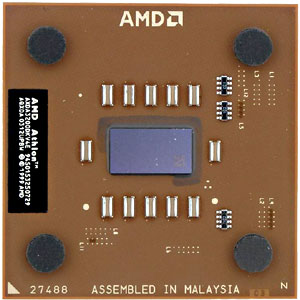
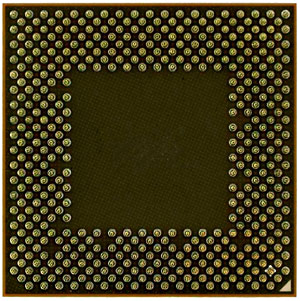
Front and rear sides of
the processor
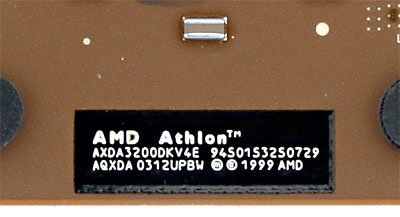
The marking for you 'AXDA3200DKV4E' - don't forget to check it to ensure
that your processor is not a fake when buying !
A real mess rules...
This seems to be an immortal topic when talking about AMD processors. It's not only that AMD always announces the specification "a minute" before the official release but also is that chipset manufacturers for AMD processors (VIA, SiS and NVIDIA) "play" with customers. The first chipset that was recognized as with the support of both 333 MHz and 400 MHz bus for the DDR memory was nForce2. But then it all changed, now it's announced that for 400 MHz DDR memory bus support you need nForce 400/nForce 400 Ultra (the last one is actually a new revision of the nForce2 northbridge).
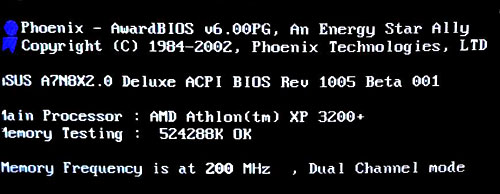
At least the processor was identified correctly
About VIA now: at the moment of VIA Apollo KT400 release it used to support DDR400, then - not (JEDEC declined its standardization), then - supports it again (all the other manufacturers have proclaimed the support of DDR400 in their chipsets so VIA decided to do the same), and then - not again ! (They announced that the full DDR400 support will only be provided in VIA KT400A). But after seeing that VIA KT400A doesn't support 400 MHz Front-Side Bus (FSB) it becomes impossible to realize why the h*ll they called it '400' and what does '600' number means in the new chipset they are going to announce (KT600). It's either because AMD doesn't know what they are to release tomorrow or they don't inform their partners about it. Although it becomes boring chipset manufacturers don't get upset and go on releasing chipsets for each AMD "caprice".
![]()
Hardware
![]() Processors:
Processors:
![]() AMD Athlon XP 2700+ (2167 MHz, 13x166 MHz) �Thoroughbred�
core, Socket 462
AMD Athlon XP 2700+ (2167 MHz, 13x166 MHz) �Thoroughbred�
core, Socket 462
![]() AMD Athlon XP 3000+ (2167 MHz, 13x166 MHz) �Barton� core,
Socket 462
AMD Athlon XP 3000+ (2167 MHz, 13x166 MHz) �Barton� core,
Socket 462
![]() AMD Athlon XP 3200+ (2200
MHz, 11x200 MHz) �Barton� core, Socket 462
AMD Athlon XP 3200+ (2200
MHz, 11x200 MHz) �Barton� core, Socket 462
![]() Intel Pentium 4 3,06 GHz (23x133 MHz), Socket 478
Intel Pentium 4 3,06 GHz (23x133 MHz), Socket 478
![]() Mainboards:
Mainboards:
![]() ASUS A7N8X
(BIOS 1002), NVIDIA nForce2 chipset
ASUS A7N8X
(BIOS 1002), NVIDIA nForce2 chipset
![]() ASUS A7N8X Rev2.00 (BIOS
1002), NVIDIA nForce2 Ultra 400 chipset
ASUS A7N8X Rev2.00 (BIOS
1002), NVIDIA nForce2 Ultra 400 chipset
![]() ASUS P4T533 (BIOS 1006 beta 001), Intel 850E
chipset
ASUS P4T533 (BIOS 1006 beta 001), Intel 850E
chipset
![]() AOpen AX4GE FM (BIOS R1.03), Intel 845GE chipset
AOpen AX4GE FM (BIOS R1.03), Intel 845GE chipset
![]() Memory:
Memory:
![]() 2x256 MB
PC3200(DDR400) DDR SDRAM DIMM Winbond, CL2
2x256 MB
PC3200(DDR400) DDR SDRAM DIMM Winbond, CL2
![]() 512 MB PC4200 RDRAM RIMM Samsung
512 MB PC4200 RDRAM RIMM Samsung
![]() Video Card:
Video Card:
![]() Palit Daytona GeForce4 Ti 4600
Palit Daytona GeForce4 Ti 4600
![]() Hard Drive:
Hard Drive:
![]() IBM IC35L040AVER07-0, 7200 rpm
IBM IC35L040AVER07-0, 7200 rpm
Software
![]() Operating System and Drivers:
Operating System and Drivers:
![]() Windows XP
Professional SP1
Windows XP
Professional SP1
![]() DirectX
8.1b
DirectX
8.1b
![]() NVIDIA
nForce UDP 2.03
NVIDIA
nForce UDP 2.03
![]() Intel
Chipset Software Installation Utility 4.10.1012
Intel
Chipset Software Installation Utility 4.10.1012
![]() Intel
Chipset Software Installation Utility 4.30.1006
Intel
Chipset Software Installation Utility 4.30.1006
![]() Intel
Application Accelerator 2.2.2
Intel
Application Accelerator 2.2.2
![]() Intel
Application Accelerator 2.3
Intel
Application Accelerator 2.3
![]() NVIDIA
Detonator XP 40.72 (VSync=Off)
NVIDIA
Detonator XP 40.72 (VSync=Off)
![]() Benchmarks:
Benchmarks:
![]() MadOnion
3DMark2001 SE build 330
MadOnion
3DMark2001 SE build 330
![]() Gray
Matter Studios & Nerve Software Return to Castle Wolfenstein v1.1
Gray
Matter Studios & Nerve Software Return to Castle Wolfenstein v1.1
![]() Croteam/GodGames
Serious Sam: The Second Encounter v1.07
Croteam/GodGames
Serious Sam: The Second Encounter v1.07
![]() discreet
3ds max 4.26
discreet
3ds max 4.26
![]() BAPCo &
MadOnion SYSmark 2002
BAPCo &
MadOnion SYSmark 2002
![]() SPECviewperf 7.0
SPECviewperf 7.0
![]() RazorLame
1.1.5.1342 + Lame codec 3.92
RazorLame
1.1.5.1342 + Lame codec 3.92
![]() VirtualDub
1.4.10 + DivX codec 5.02 Pro
VirtualDub
1.4.10 + DivX codec 5.02 Pro
![]() WinAce 2.2
WinAce 2.2
![]() WinRAR
3.11
WinRAR
3.11
![]() Cachemem
2.4MMX
Cachemem
2.4MMX
![]() Wstream
Wstream
![]() CPU
RightMark 2 RC3
CPU
RightMark 2 RC3
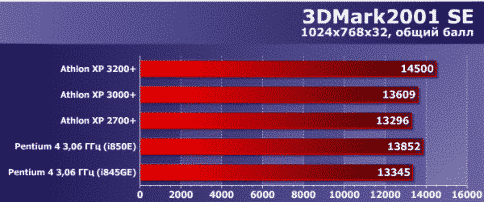
3DMark2001 SE 1024x768x32, total mark
It seems that Athlon XP is "learning" things using itself as an example. Compare the increase in productivity in 2700/3000 and 3000/3200 pairs. In this benchmark Athlon XP3200+ becomes the absolute leader leaving behind even P4 3,06 GHz. However, there are so far no results of Pentium 4 on a 800 MHz bus (Intel i865/875 chipsets), so the final results have to be delayed until the release of Athlon XP 3200+ "official" opponent - Intel Pentium 4 3,2 GHz. But P4 3,06 GHz is still VERY expensive :-)
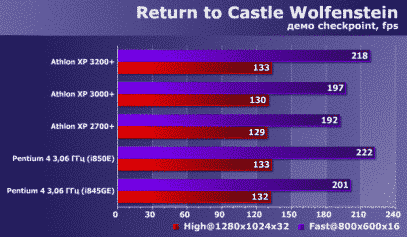
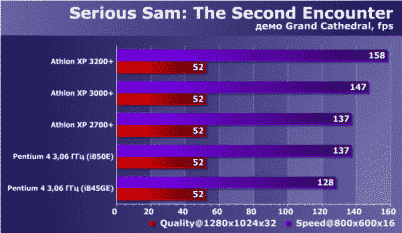
demo checkpoint, fps
demo Grand Cathedral, fps
The results are not surprising: in the first benchmark P4 wins (Quake III engine is their favorite) but is left behind in the second (Serious Sam - typical pro-Athlon XP benchmark). It's more important to note here that Athlon XP 3200+ productivity is steadily and noticeable higher than AXP3000+. This seems to be a tendency now...
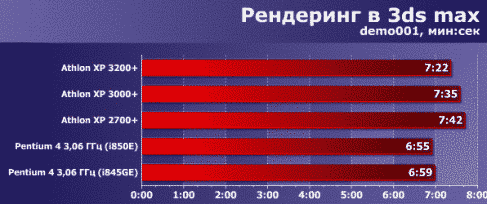
3ds max rendering, demo001, min:sec
After this package had been "sharpened" for Intel, Athlon yielded its positions (Athlon used to be an absolute leader in this benchmark). So the win of P4 in this benchmark is not a surprise. But Athlon XP3200+ doesn't win much time even in comparison with AXP2700+. This can be explained: in rendering benchmarks the frequency is a deciding factor if the processors have the same architecture (this has been proven). So 33 MHz increase in the core clock couldn't have given 3200+ model a big advantage over its predecessors.
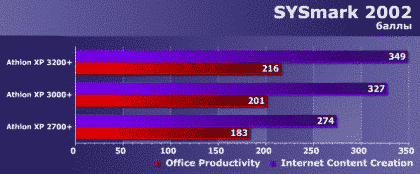
SYSmark 2002, scores
This type of benchmarks is always presented by SYSmark in my reviews. I decided to compare only Athlon XP processors excluding Intel because, in my opinion, this has become incompetent: AMD has recently laid claims to the competence of this benchmark (third-hand). Let's calculate index increase in Athlon XP 3200+ in comparison with 2700+ and compare it with the scores increase in SYSmark. 3200/2700~=1,19, i. e. 19%. Office Productivity increase: 216/183~=1,18 (the same 18%) and Internet Content Creation increase: 349/274~=1,27 (27%), that is even much bigger. So it's just wonderful that AMD processors showed its index correctness even in such a common-program benchmark as SYSmark and even in the new processors.
OpenGL
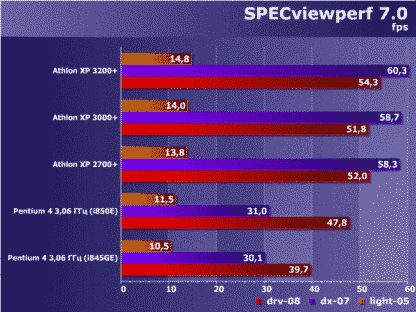
I remember what AMD said about these new instructions support...they said that all these SSE2 and SIMD are all just a craftiness... and they have a classic x87 FPU (Floating Point Unit - device for processing floating point operations - GLOPS) - the fastest, and everything is "sharpened" for it by definition. A wonderful (partial) prove for these thoughts is the SPECviewperf benchmark. SPEC programmers are notorious for their conservatism - so it's possible to surmise that they wouldn't sharpen their benchmarks for special instructions such as SSE2. So Athlon XP leaves Pentium 4 behind in ALL of the benchmarks in this system (I've just shown 3 noticeable results). So two major things can be noted: Athlon XP architecture is more "comfortable" for SPECview and that the difference in fps in Athlon XP results is not so noticeable really.
Media Data Encoding

MP3 and MPEG4 encoding using Lame 3.92 and DivX 5.02
codecs respectively; results are given in min:sec
Well it cannot be admitted that Athlon XP3200+ has almost come up with P4 (although in MP3 encoding it is true) but a huge progress has been made (that's in MPEG4) - almost 1 minute faster than 3000+ while 3000/2700 difference is only in nearly 20 seconds. These two benchmarks show that Athlon XP3200+ is a much more successful release than 3000+.
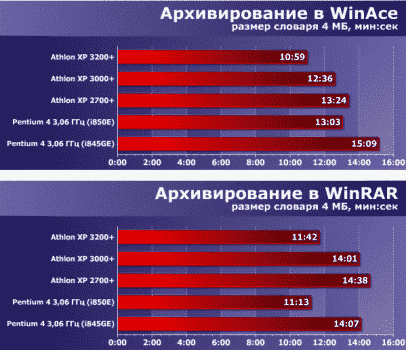
WinAce and WinRAR archiving using 4MB of lexicon each;
results are given in min:sec
Memory access speed and algorithm peculiarities are deciding factors in these benchmarks. That's why results are not surprising. A few more things - AXP3200+ is much faster than 3000+ again...it also has to be said that these benchmarks are a classical case of "architectural preferences in software": Athlon XP "feels" much better in WinAce archiving but on the contrary - in WinRAR.
Low-Level Benchmarks
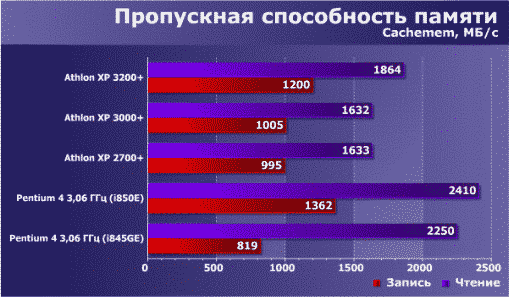
Memory Bandwidth, cachemem, MB/sec; Write - red color;
Copy - violet color.
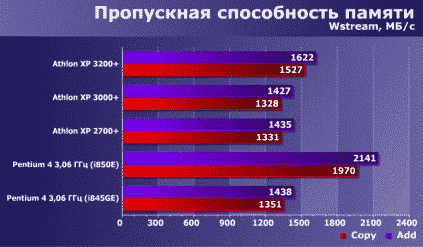
Memory Bandwidth, Wstream, MB/sec
About Athlon XP vs. Pentium 4+i850E�Do you think anything should be commented ??? Athlon XP has no chance versus P4 when it comes to dealing with memory and processor bus. But looking at i845GE results shows how important the memory subsystem is for P4. on the i845 series chipset there's nowhere to turn round for such a 3-GHz monster as P4 is.
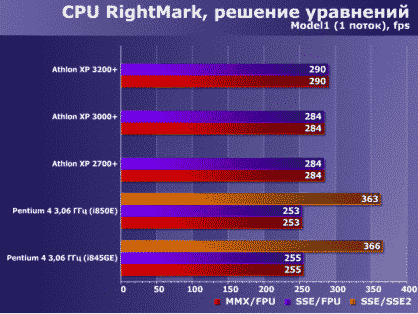
CPU RightMark, Equations Solving, Model1 (1 stream),
fps
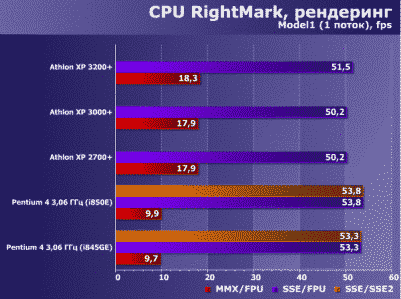
CPU RightMark, Rendering, Model1 (1 stream), fps
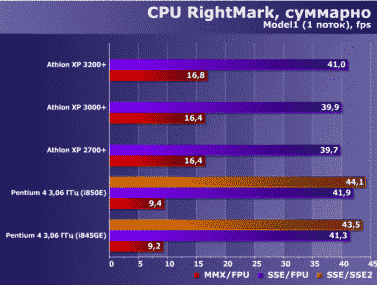
CPU RightMark, Summary, Model1 (1 stream), fps
AMD Athlon XP wins in every benchmark where the 'FPU'
word is mentioned :-) Well, it has the best FPU of all of the IA-32 processors!
But when it comes to more difficult instructions (SSE/SSE2), P4 becomes the
leader and the absolute one in SSE2. We all knew this...But the thing we didn't
know is that all Athlon XP processors tested show the same results.
Understandable...CPU RightMark measures the productivity of the processor's core
and AXP core clocks are just the same (33 MHz difference !).
Successful or not ??? Yes! Athlon XP 3200+ is not bad and it can "oppose" Intel Pentium 4 3,06 GHz. AMD promised to continue with Athlon XP series and not just forget it all in favor of Athlon 64. It would possible to see Athlon XP 3400+ released, it won't be resting on the bus clock (400 MHz). The only problem now is in chipset support. So far only nForce2 can be called a fully supporting chipset for the top Athlon XP processors. If VIA don't slow down with the release of KT600, and if SiS748 turns out to be a success; Socket-A market will become less sorrowful. I wish AMD a good luck in this business.
And for the final conclusion: the illustration of
results difference in the table and the idea that 512 KB of L2 cache (provided
in the new 'Barton' core) doesn't give a current Athlon XP processor a
noticeable increase in productivity but the FSB frequency increase really does.
| Benchmarks | 3000+ vs. 2700+ (difference, %) | 3200+ vs. 3000+ (difference, %) |
|---|---|---|
| 3DMark | +2,4 | +6,5 |
| RtCW | +2,8 | +10,5 |
| SS2 | +6,8 | +7,4 |
| 3ds max | +1,5 | +2,9 |
| ICC | +19,3 | +6,7 |
| OP | +9,8 | +7,5 |
| drv-08 | -0,5 | +5,0 |
| dx-07 | +0,7 | +2,8 |
| light-05 | +0,8 | +6,1 |
| MP3 | -0,6 | +3,8 |
| MPEG4 | +3,9 | +9,0 |
| WinAce | +6,3 | +14,7 |
| WinRAR | +4,4 | +19,8 |
| Read | -0,1 | +14,2 |
| Write | +1,0 | +19,4 |
| Copy | -0,3 | +15,0 |
| CPU RM | +0,5 | +2,8 |
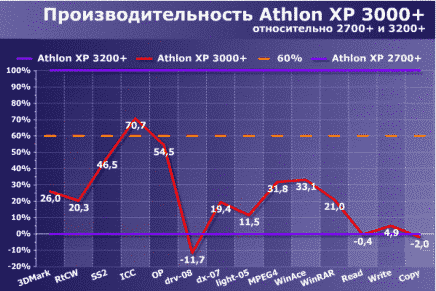
Athlon XP 3000+ Productivity in comparison with 2700+
and 3200+ models
The diagram shows the productivity of Athlon XP 3000+ processor in comparison with 3200+ (100% line) and 2700+ (0% line). Apparently, Athlon XP 3000+ results should be placed on the 60% line according to its rating (3000). See how it looks actually.
(Thanks to iXBT for help in preparing this material)
Posted by
Published on 10.02.03 21:25 GMT